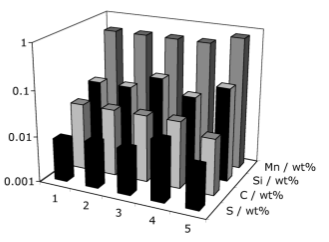

There have been many attempts in the past to reduce the variety of steels produced without compromising the range of properties available. The objective in doing so is to reduce costs. These attempts have largely focused on experiments in which thermomechanical processing parameters are varied in order to obtain a range of properties without changing the chemical composition.
We have approached this problem differently by examining a large database on hot- rolled steels, all with a final microstructure which is a mixture of ferrite and pearlite. Alloys like these form the bulk of all the steel production in the world. The database was used to create a neural network model in a Bayesian framework with inputs consisting of the chemical composition (C, Mn, Si, P, S, Cr, Ni, Mo, Ti, Nb, V, Al, N, B, Cu), the finish deformation temperature (TF) and the coiling temperature (TC); the output was either the ultimate tensile strength or tensile elongation to failure. The neural network model was then combined with a genetic algorithm to seek domains of input parameters which correspond to different target properties. The results revealed ambiguity in the inputs with respect to the required property, and the trends observed within these sets of inputs were found to be metallurgically meaningful.
Materials and Manufacturing Processes 24 (2009) 53-58

| MAP_STEEL_HOTROLLED_UTS | PROGRAM:To calculate the domain of steels and processing which can lead to the same ultimate tensile strength in hot-rolled steels. |
| MAP_STEEL_HOTROLLED_EL | PROGRAM:To calculate the domain of steels and processing which can lead to the same elongation in hot-rolled steels. |
| MAP_STEEL_HOTROLLED_UTS_EL | PROGRAM:To calculate the domain of steels and processing which can lead to the same combination of ultimate tensile strength and elongation in hot-rolled steels. |
| Coalesced | Foam | TWIP | FSW | 3D |
| Texture | Properties | Silicon | Synchrotron | Models |
| Neural Networks | Creep | Mechanicallly Alloyed | Theses | Retained Austenite |
| PT Group Home | Materials Algorithms |